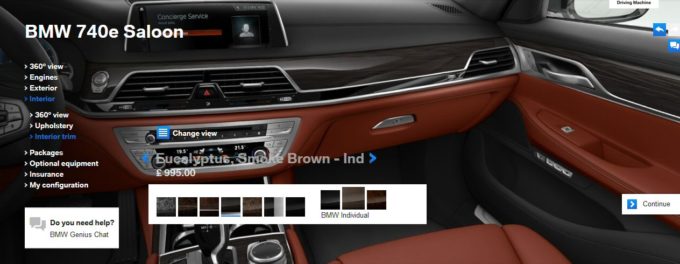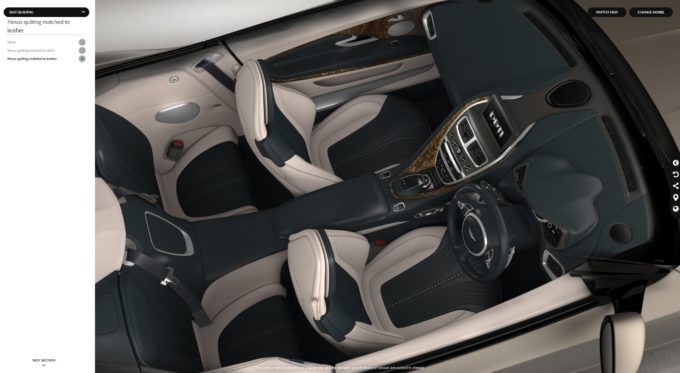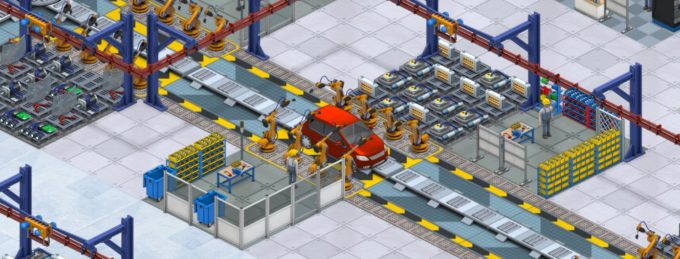Thats paraphrasing the great Ron Burgundy, in case its not clear… Anyway…
One of the main areas of game that is ‘missing’ from the current alpha build of my car-factory sim game ‘Production Line‘, is all of the high-end stuff that goes into real luxury cars. (By luxury I am meaning $100,000+) Right now it is very hard to actually make a car that you can sell for $100k without a huge markup, and although it can be argued that cars at that price range *do* have a huge markup, its not quite *that* crazy. Some of the things that spring to mind are probably high-performance engines (turbo etc, lots of cylinders, or multiple motors for electric cars), fancy bodywork such as gull-wing or falcon wing doors, and plush interiors. I’m currently thinking about the design of the ‘plush interiors’ stuff.
Although its probably declining in fashion, there is definitely a market in luxury cars for real-wood in the dashboard and other internal parts of the car, such as the area around the gear-stick (thats stick-shift for you Americans?). I am guessing that the price differential between a simple plastic dashboard like you find in most cars to a smooth polished and multi-layered varnished wooden dashboard is probably pretty massive. FWIW I used to varnish mahogany for a living. its harder than it looks, especially if you want that smooth-as-glass finish without a single blemish. Its all about removing all the dust. I digress…
A quick glance at the BMW configurator (UK) for the 740e saloon (about the right price range) shows me such options as ‘fineline wood high gloss’ for ‘included in price’ to ‘Eucalyptus smoke brown’ for an extra £995 ($1,373). Thats a nice handy nudge towards luxury pricing in my game! Wooden dashboards here we come.

Dashboards are just one thing, what about all that shiny chrome stuff you get in cars, surely that costs a bit too? Indeed it can. A pair of chrome wing-mirror covers for the Jaguar XJR (A stupidly slow and overpriced low-tech car for the money…but again…I am getting distracted) will cost you… £198 ($273). Even Aluminium gearshift paddles cost £389. its hilarious how peoples sense of perspective implodes the minute they buy a luxury car. Anyway, its amazing how many bits of a car you can cover in chrome, if you want to give it a ‘luxury’ feel, and I certainly don’t want to bore the player (and complicate the GUI) with a bazillion options, so I was thinking of just including a single ‘chrome fixtures’ upgrade for luxury cars in the game. I’m guessing $1,000 should cover it? I’m amused to discover both that Aston martin calls this stuff ‘jewellery pack’ and that it doesn’t price it separately! haha. Its configurator is hilariously gratuitous.

The third option that I plan to add soon is that of interior lighting. The Ford ‘edge’ talks about ‘enhanced ambient lighting’. This is the stuff you dont notice until its gone, but it includes subtle lights in the foot-well by the pedals, the lights by the door handles on the inside, and those cool lights that gently fade in and out when activated rather than snapping on. Looking at the difference between models, I think some companies are charging up to $700 for a ‘premium ambient lighting package’.
So that gives us an extra $3,000 of new features to push up the price of our car. To summarize:
- Premium ambient lighting package
- Wooden Dashboard
- Chrome fixtures
Thats the easy bit, where do we add these in the production line? Right now we have ‘fit dashboard’ which is part of the larger ‘fit accessories’ task. At the moment it takes 2.0 seconds of player time, but it has a number of additional options, such as ‘driver and passenger airbags, a heater, and touchscreen. This already can cause a bit of a bottleneck, so how about this as a solution:
- Split the existing ‘fit dashboard into two tasks: ‘fit controls’ and ‘fit cabin options’. I can rename the original ‘fit dashboard to ‘fit interior’.
- Set the wooden dashboard, chrome fixtures and premium lighting to be options under ‘fit cabin options’
- Set the airbags, heater and touchscreen to be options under ‘fit controls’

The only problem with this would be that if I have the fit interior needing research to be split into two, that means you need to do this research AND expand the line slightly before fit heater & airbags and touchscreen become an option. What I *could* do here is to allow them to also be options under the parent, which should work AFAIK, but is something I have not done before. Would that be confusing? Hmmm.
So question one is does this work for everyone as a system to incorporate these new features in the production line. Wooden dashboard would require the new wood resource, chrome requires chrome, and ambient lighting would need sensors and light bulbs (also a new resource).
My second question on this is where these items should be researched. Wooden dashboards isn’t really a ‘technology’ so might it be something we can add to the design studio instead? That facility does become redundant once all the current body types are done. Or… is that going to lead to confusion? Also surely getting the right production processes to build a wooden dashboard surely *is* a sort of technology? Hmmm.
As always, thoughts and opinions are very welcome.